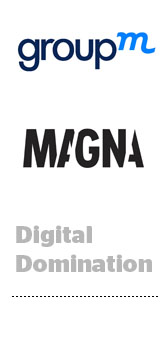 Both WPP’s GroupM and IPG’s Magna pinpoint 2017 as the year digital ad spend finally surpasses linear TV, according to forecasts each media-buying unit released Monday.
Both WPP’s GroupM and IPG’s Magna pinpoint 2017 as the year digital ad spend finally surpasses linear TV, according to forecasts each media-buying unit released Monday.
Magna noted that digital grew 17% globally this year to $178 billion. That’s $27 billion in growth – and $26 billion of that came from digital. GroupM predicts that digital will account for 33% of global ad spend in 2017.
“Digital is now the biggest advertising generator in the US, slightly above TV,” said Vincent Letang, EVP global market intelligence at Magna. “We’ve been predicting that for about two years, and it happened. The same will happen on a global level next year.”
Magna predicts that by 2021, digital will represent half of global ad sales. And programmatic, which reached $19 billion in spend this year, has been and will continue to be a huge contributor as it reaches $42 billion by 2020.
By then, however, mobile and video will represent the majority of programmatic spend.
Magna pinpointed mobile as the growth engine for all digital in 2016 Mobile ad spend grew to $80 billion this year to represent 45% of total digital spend. By 2021, it will reach $215 billion, or 72% of digital spend. Meanwhile, desktop ad spend stagnated this year in the US and shrank in other markets.
Within mobile, video and social formats were the main drivers of growth in 2016. Social media grew 46% to $33 billion, and video fueled 15% of that growth. Excluding social video, digital video grew by 27%. Letang expects video growth to slow in 2017 as the medium matures.
“Last year, video was still in its infancy,” he said. “It’s going to be hard to have the same growth rate in 2017, considering video was already pretty big and successful this year.”
But Magna predicts global ad spend will slow next year due to political uncertainty around Donald Trump’s presidency and Brexit, as well as a lack of tentpole events. North America saw its strongest growth rate in 12 years in 2016 at 6.7%, but Magna says next year will be its most significant slowdown in 15 years at just 3.6% growth.
GroupM predicts global ad spend will slow to 4.4% growth in 2017.
TV’s Future
Despite digital cannibalization, TV grew 4% to $186 billion this year thanks to tentpole events like the Olympics and the US election, Magna reported.
And major CPG brands like Procter & Gamble reallocated budgets for broad reach after experiencing poor results from digital’s “overtargeting,” noted both Magna and GroupM. No digital alternative can offer the mass reach of TV yet.
As increasing demand for linear TV inventory met a shrinking pool of supply this year, pricing inflation of 8-10% helped pad broadcast budgets, Letang said.
“A lot of mainstream brands feel like they absolutely need what’s left of the reach,” he said. “So far, and I insist on so far, they have been ready to take on significant inflation. In the long term, the [digital] alternatives will become more substitutable and the demand for TV will reduce.”
Magna said 2016 represents a “tipping point in media consumption.” Olympic viewership was down 33% for adults 18-49. Award ceremonies and NFL games also had viewership declines.
This post was syndicated from Ad Exchanger.

More Stories
Trifecta for OMD at Cannes Young Lions 2024
Ogilvy Names Rafael Rizuto Chief Creative Officer for North America
NZME podcast Sex.Life hits 1 million downloads